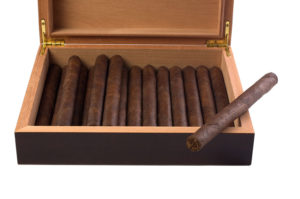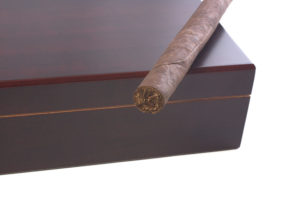 Most of the time, when I approach a newer smoker, or even a seasoned smoker for that matter, the subject of strength usually comes up in the conversation. Almost every smoker is under the misconception that the darker the wrapper, the stronger the cigar. In fact, the wrapper has nothing to do with the overall strength of the cigar with the exception of sun-grown wrappers. The darker colors are due to either the aging of tobacco or the tobacco having undergone a process that makes it a maduro.
Most of the time, when I approach a newer smoker, or even a seasoned smoker for that matter, the subject of strength usually comes up in the conversation. Almost every smoker is under the misconception that the darker the wrapper, the stronger the cigar. In fact, the wrapper has nothing to do with the overall strength of the cigar with the exception of sun-grown wrappers. The darker colors are due to either the aging of tobacco or the tobacco having undergone a process that makes it a maduro.
A maduro is a very dark leaf, usually shades of chocolate brown, but sometimes can be almost black (in this case called an oscuro). The maduro is not a particular type of tobacco, but rather a process that some different strains of tobacco go through. The process is very similar to composting, but without completing the compost process.
The term maduro quite literally means “ripe.” A tobacco leaf goes through a 72-day drying period where it changes in color from green to brown. The selected leaves are then piled in huge stacks called “pilons.” The pilons are covered with a tarp to help hold in the heat during the compost process. The temperatures of the leaves in the pilon are constantly checked, and when they reach a certain temperature, the leaves are turned. This process continues for up to two years before the leaf is ready to be a maduro wrapper.
Most of the better cigar factories use the two-year process while others have learned to speed up the composting. Some cigar companies add chemicals to help generate heat while others heat the rooms where the tobacco is composting, a term called “baking.” Another counterfeit maduro is one that has been artificially colored. The easiest way to tell if any of these methods had been used is to see if you have an ammonia taste during or after the smoke. This is a sign that the tobacco has not had the proper time to bleed off the ammonia. Both the colored and the baked maduros are fairly easy to spot in that their color is not a healthy brown but a charred, dull black.
The wrapper gives a cigar between 40 and 80 percent of its flavor, with maduro wrappers giving the most. Maduros have a rich body, flavor and character. They also have a sweetness that comes from the starches in the tobacco becoming sugars from the aging/heating. The nicotine content is greatly reduced as well giving the wrapper no “strength.” Some cigars are “double maduros” in which both the wrapper and binder are maduros.
Maduros vary in flavor, but overall, the properly made ones have a sweet, oily and sometimes earthy flavor depending on the type of leaf used. Some can even have a slight spice, a hint of pepper. Overall, maduros tend to be lighter, using more volado and seco and less ligero leaves.
For beginners, I would recommend Los Blancos maduro. It has no ligero and has a nice balance of seco and volado giving it a mild body. Being the only brand that makes a Habana 2000 maduro, it has unique, pleasant taste. Los Blancos also puts out a Connecticut and Criollo wrapper with the same fill. This enables the smoker to taste the difference without having the fill and binder interfere.
Rocky Patel does the same thing with the Edge, but instead of using a Criollo wrapper, a Corojo wrapper is used. For a much fuller bodied smoke, I find the Rocky Patel Olde World Reserve is as good as it gets. Light up and enjoy.